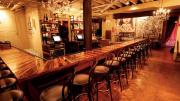If you’re 30-plus and want a fun night out with live music and a splash of funk, where do you go? The clubs and bars lining Lansdowne and Boylston streets are out of the question (too many giddy kids, too little substance). Back Bay lacks edge. And the South End’s restaurants serve terrific food, but not much else. Enter the theatrically charged Beehive, which opened in the Boston Center for the Arts on Tremont Street in May.
Creative cocktails top the bistro-style menu of high-end comfort food, such as macaroni and cheese with lobster and asparagus for $20. Burlesque acts or music —jazz, soul, cabaret, or R&B, often featuring fresh-faced performers from the Berklee College of Music—typically start after 9 nightly.
Housed on two levels, the Beehive accommodates 300 people, but downstairs is the place to be. One room, flaunting gothic/bordello décor and red lights, holds café tables and the stage, which is framed with burgundy drapes. The adjacent room has a buzzing bar scene with more of a boiler-room-meets-Parisian-shabby-chic feel: exposed pipes and brick walls contrast with glittering chandeliers, French doors lead outside, and racks of antlers hang here and there. It’s visually captivating, but can be fairly noisy, especially when the musicians get going.
Named for La Ruche, a hive-shaped artists’ residence in 1900s Paris, the Beehive boasts a waitstaff of artists and performers who cater to a diverse, creative crowd, many of whom are unafraid to don sparkly costumes or other thoroughly original (for Boston) garb. The scene was monitored, in part, by a muscular door guard who strode around in a floor-length leather coat and Secret Service-type earphone.
We wished the food had offered as much intrigue. It was inconsistent, as if some inexperienced actors had been cast in this otherwise ravishing production.
Things started off very well. The charcuterie board ($15) featured grilled kielbasa and three sumptuous slabs of pâté (duck, and combinations of pork, chicken, and goose) served with chewy peasant bread and pickled onions. The cubed beet salad with fresh arugula ($10) had the right balance of blue cheese and candied walnut bits in a surprisingly delicate vinaigrette. Also satisfying were the tender and gamey pork dumplings ($9) with disks of spicy radish and an apple-curry aioli.
The entrées we ordered (we didn’t try them all) lacked such interest or nuance. The paella ($23) had the usual suspects: mussels, chorizo, peppers, clams, and shrimp. But apart from the stellar sausage, the flavors were indistinct (no saffron detected), and the rice was soggy. The much too salty roasted organic salmon ($23) arrived over dowdy buttered polenta with a pile of leggy watercress.
For dessert, we’d recommend the lemon crème brûlée ($7) drizzled with pomegranate juice. But the starchy, faintly oily carrot-coconut bread pudding ($7) was bland, and the swirl of grainy cream cheese on top looked unappetizingly like mustard. We longed for a warm, eggy pudding with incisive, whiskey-spiked hard sauce.
Despite these disappointments, the Beehive is a welcome addition for those of us hungry for a vibrant restaurant that can showcase the city’s fledgling musical and theatrical talents and feed its maturing artistic patrons.
~N.P.B.






